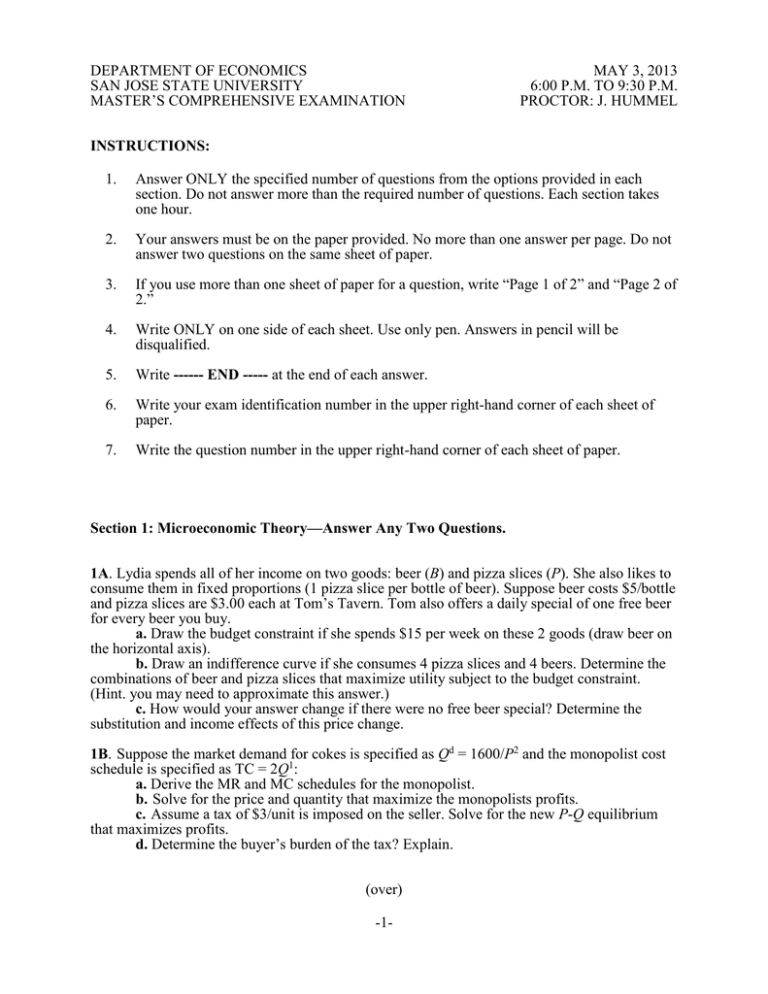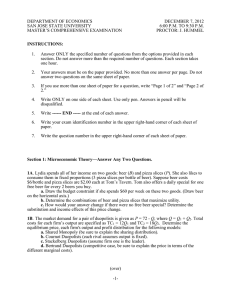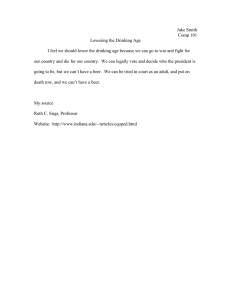DEPARTMENT OF ECONOMICS MAY 3, 2013 SAN JOSE STATE UNIVERSITY
advertisement

DEPARTMENT OF ECONOMICS SAN JOSE STATE UNIVERSITY MASTER’S COMPREHENSIVE EXAMINATION MAY 3, 2013 6:00 P.M. TO 9:30 P.M. PROCTOR: J. HUMMEL INSTRUCTIONS: 1. Answer ONLY the specified number of questions from the options provided in each section. Do not answer more than the required number of questions. Each section takes one hour. 2. Your answers must be on the paper provided. No more than one answer per page. Do not answer two questions on the same sheet of paper. 3. If you use more than one sheet of paper for a question, write “Page 1 of 2” and “Page 2 of 2.” 4. Write ONLY on one side of each sheet. Use only pen. Answers in pencil will be disqualified. 5. Write ------ END ----- at the end of each answer. 6. Write your exam identification number in the upper right-hand corner of each sheet of paper. 7. Write the question number in the upper right-hand corner of each sheet of paper. Section 1: Microeconomic Theory—Answer Any Two Questions. 1A. Lydia spends all of her income on two goods: beer (B) and pizza slices (P). She also likes to consume them in fixed proportions (1 pizza slice per bottle of beer). Suppose beer costs $5/bottle and pizza slices are $3.00 each at Tom’s Tavern. Tom also offers a daily special of one free beer for every beer you buy. a. Draw the budget constraint if she spends $15 per week on these 2 goods (draw beer on the horizontal axis). b. Draw an indifference curve if she consumes 4 pizza slices and 4 beers. Determine the combinations of beer and pizza slices that maximize utility subject to the budget constraint. (Hint. you may need to approximate this answer.) c. How would your answer change if there were no free beer special? Determine the substitution and income effects of this price change. 1B. Suppose the market demand for cokes is specified as Qd = 1600/P2 and the monopolist cost schedule is specified as TC = 2Q1: a. Derive the MR and MC schedules for the monopolist. b. Solve for the price and quantity that maximize the monopolists profits. c. Assume a tax of $3/unit is imposed on the seller. Solve for the new P-Q equilibrium that maximizes profits. d. Determine the buyer’s burden of the tax? Explain. (over) -1- DEPARTMENT OF ECONOMICS SAN JOSE STATE UNIVERSITY MASTER’S COMPREHENSIVE EXAMINATION MAY 3, 2013 6:00 P.M. TO 9:30 P.M. PROCTOR: J. HUMMEL 1C. Given a Utility Function U = U(X1, X2) = X1X2 and a budget constraint 100 = 10X1 + 5X2: find the optimal levels of X1 and X2 that can maximize the utility level subject to the budget constraint. (You must use the Lagrange method, and you do not need to check the second order conditions.) -2-


